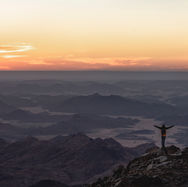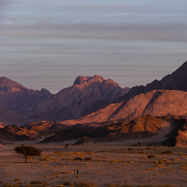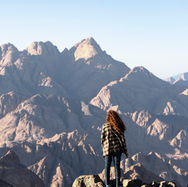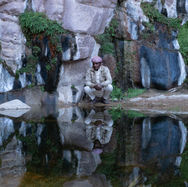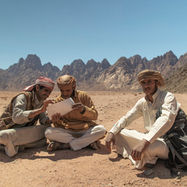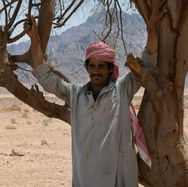RED SEA MOUNTAIN TRAIL
Documentary Short | 2019
Written & Directed by: Hamsa Mansour & Nour El Din
Cinematography by: Nour El Din
Client: Red Sea Mountain Trail
On January 2019, our founders joined the Red Sea Mountain Trail ‘s team by becoming the trail’s official storytellers and documentarians. We spent 8 days shooting the trail then joined the trail's first official hike and there we saw some of the most beautiful sceneries and landscapes in Egypt. We hiked, climbed, repelled, used ropes to climb down dry waterfalls, walked on shaky ridges and scrambled up mountains and teared up several times from the views we saw.
The RSMT is a 170km trail extending through the deserts of Hurghada, and inhabited by the Koshman Clan of the Maaza tribe; one of Egypt’s biggest tribes. Ben Hofler, founder of RSMT & Sinai Trail spent years walking the lands with the bedouins and connecting the old paths to form what is now the RSMT. At the first glance, the trail feels rougher than most trails in Egypt. It hasn't been walked in a very long time, you can’t see a clear path to follow, and the mountains look unforgiving from afar. This changes when you start walking and experiencing the diverse landscapes and cultures along the trail; from mountains standing tall on very vast wadis, magnificent water pools, greenery and canyons to old Roman towns, prehistoric drawings and nomadic families who have survived here for centuries.
The Maaza tribe migrated from Saudi Arabia to Egypt between the eighteenth and nineteenth centuries, residing in the Eastern Desert, between Ras Ghareb and El Quesseir and reaching Qena on the Nile banks. The tribe is one of the biggest tribes in Egypt, comprising about 20 clans who trace their name back to their great grandfather “Moaz Ibn Jabbal”. The Koshman Clan is the one living on the RSMT.
While most of the clan left the desert for the city, searching for work and education for their children, some families still embrace the nomadic life and refuse to move to the cities.
We spent the 8 days with Mohammed El Muteer - our guide-, Ben Hofler, and Omar Marei - Driver and son of the Tribe’s Sheikh-, we spent the days walking and climbing with Mohamed and Ben to film and get down for a short breaks in the shade Omar had setup a shade before using the 4x4 to travel across vast Wadis to hike and climb again, we used the car as we needed to film most of the trail in little time.
Mohammed was our guide, and we consider him a family member now. Mohammed grew up in the mountains. This is how he cultivated the unparalleled knowledge he has for the mountains, Wadis and vegetation. Mohammed walked on the trail more than anyone else, he and Ben Hoffler walked together for years to develop the trail so he can share his knowledge with future generations and hikers, he taught us a lot about the history of the place, the culture and the plants’ benefits, -at one point- curing Nour’s stomachache using baatharan, a plant on the trail.
Mohamed has 2 young girls and he believes in the importance of teaching them about life through nature as well as getting their academic education. One of his dreams is to have his daughters write all of the stories he knows about the people and the places so the stories would live on.
Mohamed and the other Nomadic families on the trail are true pastoral nomads; they depend on livestock, don’t have fixed habitation but rather move around, from one place to another following the rain, searching for spots with access to water and grazing areas for their herd. They value the calm life they have in the mountains and they make a living by selling livestock and plants to the families living in the cities and use this money to buy grains and legumes as they can survive the heat.
We were amazed by more than the bedouin hospitality on the trail and the families that took us in, we were welcomed to sit around rings of fire with entire families, men and women of three different generations, to talk, eat and bond. It is not common to be able to sit with the women and take their photos in the bedouin culture. The younger generation of those families have never met outsiders before us. In the first family we met two girls who were reserved and curious, they wanted to understand how the camera and laptops work with little interaction, and in the second Family, we met Mohammed, a young boy who wanted us to play with him once we met, he would take his wood stick, pretend it is a motorcycle, run around and pose for the camera then run back to see how he looks on the screen, he did this all day, everyday until he would drop asleep on the ground out of exhaustion.
The families live by the nature’s rules and do their best to leave no trace wherever they go, to preserve the place. One day we walked across a skull of a Nubian Ibex and Mohamed, asked us to not include him in the picture with the skull as hunting Ibexes is prohibited and he doesn’t want anyone to think he encourages it. Our guides told us they used to see them more frequently 10-15 years ago, the Nubian Ibex are classified as “vulnerable”, this means there are less than 10,000 individuals with declining population.
The mountains on the Red Sea Mountain Trail will always surprise you. Starting with Jebel Qattar, a magnificent labyrinth of wonders where El Nagatta lies, a huge green wall and water pool, formed by the water continuously dripping from the mountains, Jebel Um Samyouk’s adventurous climb where we scrambled for hours, mostly on loose grounds to witness the sunset overlooking the tablelands of the eastern banks of the Nile to feeling like we are walking in movie sets and discovering giant water pools in the middle of rough wadis.
We are also happy to have witnessed the trail’s first official hike and how to bedouin guides dealt with leading 20+ hikers through their rugged lands for the first time.

